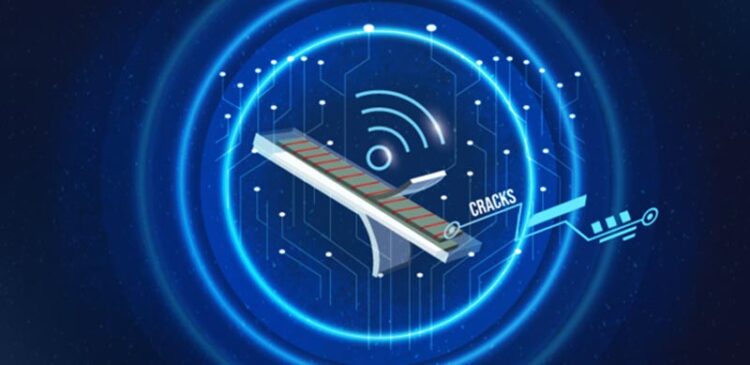Wireless strain sensors cracked up to be better

KAUST scientists develop a sensor that can monitor the strain in materials and wirelessly communicate the signal, which is particularly useful for measuring strain in hard-to-reach places.
Credit: © 2021 KAUST; Veronica Moraru
Controlling the structure of fragmented electrodes composed of carbon nanotubes could offer improved wireless monitoring of the strain on materials in a wide range of applications.
“This opens endless possibilities for every situation where accurate wireless monitoring of structures is important,” says Gilles Lubineau, Professor of Mechanical Engineering at KAUST.
Lubineau developed the technology with postdoc Hussein Nesser, who adds: “Our sensor can directly be used to assess, in-situ and with great accuracy, the strain exerted on materials.”
Monitoring the strains imposed on materials is crucial for checking the safety of everything from buildings and bridges to ships and aircraft. Strain sensors are also important subdevices for monitoring aspects of health, sports performance and robotics. Natural, manufactured and living structures are all exposed to stresses and strains that can compromise their integrity.
Most strain sensors are composed of a material that can convert physical deformation into changes in electrical resistance or capacitance. The resulting electrical signals have traditionally been carried to the detecting devices along wires, but more recently, wireless technology is bringing the obvious advantages of remote sensing. This is especially useful for detecting the strains on materials in difficult-to-reach locations, such as inbuilt structures, vehicles or inside the body.
Existing wireless systems, however, are beset by problems of low sensitivity. KAUST researchers have tackled these problems by introducing a special pattern of cracks into fragmented electrodes in a way that greatly increases the sensitivity of the electrical responses. While the team was working on such a concept in the past for resistive sensors, this is the first time it has been applied to capacitive sensors that are more suitable for passive wireless applications.
Their sensor is essentially an electrical capacitor with carefully fragmented electrodes made of carbon nanotube-containing paper. The electrical changes caused by different levels of strain generate signals that can be captured wirelessly by electromagnetic coupling.
“Our innovation brings high gauge factor to the world of wireless strain detection,” says Lubineau. Gauge factor describes the ratio of the generated electrical signal to the level of strain.
Having demonstrated their concept in principle, the researchers now plan to embed it into readily deployable systems suitable for commercialization. They will also investigate using it to detect other physical properties of materials in addition to strain.
“Our ultimate objective is to make a new generation of wire-free, battery-free and ultralow-cost sensors,” says Nesser.
Journal: ACS Applied Materials & Interfaces
DOI: 10.1021/acsami.1c07704
Method of Research: Experimental study
Article Title: Achieving Super Sensitivity in Capacitive Strain Sensing by Electrode Fragmentation
Article Publication Date: 26-Jul-2021
All latest news from the category: Power and Electrical Engineering
This topic covers issues related to energy generation, conversion, transportation and consumption and how the industry is addressing the challenge of energy efficiency in general.
innovations-report provides in-depth and informative reports and articles on subjects ranging from wind energy, fuel cell technology, solar energy, geothermal energy, petroleum, gas, nuclear engineering, alternative energy and energy efficiency to fusion, hydrogen and superconductor technologies.
Newest articles

First-of-its-kind study uses remote sensing to monitor plastic debris in rivers and lakes
Remote sensing creates a cost-effective solution to monitoring plastic pollution. A first-of-its-kind study from researchers at the University of Minnesota Twin Cities shows how remote sensing can help monitor and…

Laser-based artificial neuron mimics nerve cell functions at lightning speed
With a processing speed a billion times faster than nature, chip-based laser neuron could help advance AI tasks such as pattern recognition and sequence prediction. Researchers have developed a laser-based…

Optimising the processing of plastic waste
Just one look in the yellow bin reveals a colourful jumble of different types of plastic. However, the purer and more uniform plastic waste is, the easier it is to…



